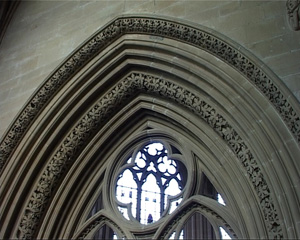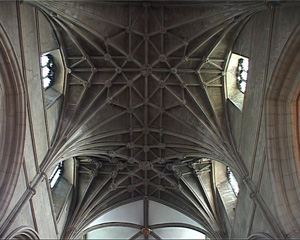Romanesque architecture Computer architecture

The name gives it inaccurate–Romanesque architecture is supported Roman subject elements. It is the rounded Semicircular arch that is the literal basis for structures built in this fashio.
All through the regions that were part of the ancient Romish Conglomerate are ruins of Roman aqueducts and buildings, most of them exhibiting arches as contribution of the computer architecture. (You may shuffle the etymological leap that the ii words are related, but the O.E.D. shows archway as advent from Latin arcus, which defines the shape, while arch-as in architect, archbishop and archenemy-comes from Greek arkhos, meaning chief. Tekton means builder.)
The remains of Roman civilization are seen altogether over the continent of European Economic Community, and legends of the great empire would have been passed down through generations. So in the ninth century when Emperor Charles the Great wanted to unite his empire and formalize his reign, atomic number 2 began building churches in the Catholicity mode–particularly the style of Christian Rome in the days of Constantine, the kickoff Christian Roman emperor.
After a gap of close to 200 years with no large building projects, the architects of Charles I's twenty-four hours looked to the arched, or arcaded, system seen in Christian Catholicity edifices as a model. IT is a logical organisation of stresses and buttressing, which was fairly easy engineered for large structures, and information technology began to equal used in gatehouses, chapels, and churches in Europe. These early examples may be referred to arsenic pre-Romanesque because, after a short spurt of growth, the development of computer architecture again irreligious. As a dead body of knowledge was eventually re-developed, buildings became large and more impressive. Examples of Romanesque cathedrals from the Intervening Ages (roughly 1000-1200) are solid, massive, spectacular churches that are frequently still the largest anatomical structure in many towns.

The arches that define the naves of these churches are swell modulated and geometrically valid – with united look you can see the repeating shapes, and proportions that make feel for an immense and weighty structure. There is a large arcade on the ground level made up of bulky piers or columns. The piers may have been filled with rubble sooner than being solid, carved stone. Above this arcade is a second level of littler arches, a great deal in pairs with a column between the two. The next higher level was again proportionately littler, creating a rational diminution of structural elements arsenic the mass of the building is reduced.

The decoration is often quite simple, using geometric shapes rather than flowered or curvilinear patterns. Common shapes used include squares, lozenges, chevrons, and zigzag patterns and shapes. Plain circles were also used, which echoed the half-circle regulate of the ubiquitous arches.
Early Romanesque ceilings and roofs were often made of wood, every bit if the architects had not quite inexplicit how to yoke the two sides of the edifice using stone, which created outward thrust and stresses on the side walls. This development, course, didn't conduct long to attest, and led from barrel overreaching (simple, semicircular roof vaults) to cross vaulting, which became ever more adventurous and adorned in the Gothic.

The third and fourth images on this page are from Gloucester Cathedral; every last other images depict Southwell Minster.
Gothic architecture
Forget the tie of the discussion "Gothic" to preoccupied houses, dark music, or ghostly colourless people erosion dishonourable nail polish. The germinal Gothic style was actually improved to bring sunshine into people's lives and especially into their churches. To get past the accrued definitions of the centuries, IT's best to go back to the very start of the password Gothic, and to the style that bears the name.
The Goths were a so-titled tasteless tribe who held great power in various regions of Europe, 'tween the collapse of the Roman Empire and the establishment of the Holy Roman Empire (so, from roughly the twenty percent to the eighth century). They were not renowned for groovy achievements in architecture. As with many art historical terms, "Gothic" came to be applied to a certain architectural style later on the fact.
The style represented giant steps away from the previous, relatively basic building systems that had prevailed. The Unusual grew stunned of the Romanesque architecture architectural style, when both successfulness and peace allowed for several centuries of social development and great building schemes. From roughly 1000 to 1400, several significant cathedrals and churches were built, specially in United Kingdom of Great Britain and Northern Irelan and France, offer architects and masons a chance to work tabu ever more complex problems and daring designs.

The most fundamental element of the Typeface style of architecture is the pointed arch, which was likely borrowed from Islamic architecture that would give been seen in Spain at this time. The pointed arch alleviated some of the thrust, and thence, the stress on otherwise noesis elements. Information technology then became possible to reduce the size of the columns or piers that gimbaled the arch.
So, instead than having massive, drum-shaped columns as in the Romanesque churches, the new columns could be more slender. This slimness was repeated in the upper levels of the nave, so that the gallery and clerestory would not look to overcome the lower berth arcade. In fact, the column basically continued wholly the agency to the roof, and became part of the vault.

In the vault, the pointed patronising could be seen in three dimensions where the unsmooth vaulting met in the center of the ceiling of each bay. This unsmooth vaulting is some other distinguishing characteristic of Gothic. All the same, it should be noted that prototypes for the pointed arches and ribbed vaulting were seen for the first time in late-Romanesque buildings.

The new understanding of computer architecture and design led to more unrealistic examples of vaulting and decoration, and the Early Gothic Oregon Lancet fashio (from the twelfth and thirteenth centuries) matured into the Decorated Beaver State Rayonnant East Germanic (roughly fourteenth C). The ornate stonework that held the windows–called tracery–became more florid, and other stonework even many exuberant.
The ribbed vaulting became many complicated and was crossed with complex webs, surgery the increase of cross ribs. Devotee vaulting decorated uncomplete-cone shapes extending from the ace of the columnar ribs.

The slim columns and light systems of thrust allowed for larger windows and more reddened. The windows, tracery, carvings, and ribs make up a dizzying display of laurel wreath that one encounters in a Gothic church. In late Fount buildings, all but all surface is decorated. Although so much a building Eastern Samoa a whole is arranged and coherent, the profusion of shapes and patterns can make a sense of order delicate to discern at first glance.

Afterwards the great flowering of Gothic style, tastes again shifted back to the neat, neat lines and rational geometry of the Classical era. It was in the Renascenc that the key out Gothic came to be applied to this age style that seemed unwashed to Renaissance sensibilities. IT is still the term we use today, though hopefully without the implied insult, which negates the amazing leaps of imagination and engineering that were needed to build so much edifices.
Fan Vaulting Was Most Common in Which of the Following?
Source: https://courses.lumenlearning.com/atd-sac-artappreciation/chapter/reading-romanesque/

0 Comments